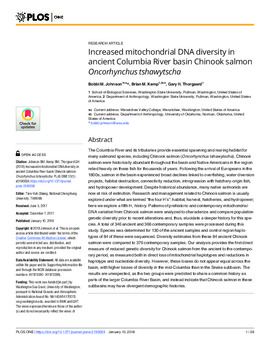| dc.contributor.author | Johnson, Bobbi M. | |
| dc.contributor.author | Kemp, Brian M. | |
| dc.contributor.author | Thorgaard, Gary | |
| dc.date.accessioned | 2018-03-16T14:52:16Z | |
| dc.date.available | 2018-03-16T14:52:16Z | |
| dc.date.issued | 2018-01-10 | |
| dc.identifier.citation | Johnson BM, Kemp BM, Thorgaard GH (2018) Increased mitochondrial DNA diversity in ancient Columbia River basin Chinook salmon Oncorhynchus tshawytscha. PLoS ONE 13(1): e0190059. https://doi.org/10.1371/journal.pone.0190059 | en_US |
| dc.identifier.uri | https://hdl.handle.net/11244/54642 | |
| dc.description.abstract | The Columbia River and its tributaries provide essential spawning and rearing habitat for many salmonid species, including Chinook salmon (Oncorhynchus tshawytscha). Chinook salmon were historically abundant throughout the basin and Native Americans in the region relied heavily on these fish for thousands of years. Following the arrival of Europeans in the 1800s, salmon in the basin experienced broad declines linked to overfishing, water diversion projects, habitat destruction, connectivity reduction, introgression with hatchery-origin fish, and hydropower development. Despite historical abundance, many native salmonids are now at risk of extinction. Research and management related to Chinook salmon is usually explored under what are termed “the four H’s”: habitat, harvest, hatcheries, and hydropower; here we explore a fifth H, history. Patterns of prehistoric and contemporary mitochondrial DNA variation from Chinook salmon were analyzed to characterize and compare population genetic diversity prior to recent alterations and, thus, elucidate a deeper history for this species. A total of 346 ancient and 366 contemporary samples were processed during this study. Species was determined for 130 of the ancient samples and control region haplotypes of 84 of these were sequenced. Diversity estimates from these 84 ancient Chinook salmon were compared to 379 contemporary samples. Our analysis provides the first direct measure of reduced genetic diversity for Chinook salmon from the ancient to the contemporary period, as measured both in direct loss of mitochondrial haplotypes and reductions in haplotype and nucleotide diversity. However, these losses do not appear equal across the basin, with higher losses of diversity in the mid-Columbia than in the Snake subbasin. The results are unexpected, as the two groups were predicted to share a common history as parts of the larger Columbia River Basin, and instead indicate that Chinook salmon in these subbasins may have divergent demographic histories. | en_US |
| dc.language | en_US | en_US |
| dc.relation.uri | http://journals.plos.org/plosone/article?id=10.1371/journal.pone.0190059 | |
| dc.rights.uri | https://creativecommons.org/licenses/by/4.0/ | |
| dc.subject | Ancient DNA | en_US |
| dc.subject | Anthropology, Molecular | en_US |
| dc.subject | Haplotypes | |
| dc.subject | Salmon | |
| dc.subject | Snakes | |
| dc.subject | Paleogenetics | |
| dc.subject | Freshwater fish | |
| dc.subject | Spawning | |
| dc.subject | Population genetics | |
| dc.subject | Rivers | |
| dc.title | Increased mitochondrial DNA diversity in ancient Columbia River basin Chinook salmon Oncorhynchus tshawytscha | en_US |
| dc.type | Article | en_US |
| dc.description.peerreview | Yes | en_US |
| dc.identifier.doi | https://doi.org/10.1371/journal.pone.0190059 | en_US |
| ou.group | College of Arts and Sciences::Department of Anthropology | en_US |
| dc.contributor.sponsor | University of Oklahoma Libraries Open Access Fund | |

